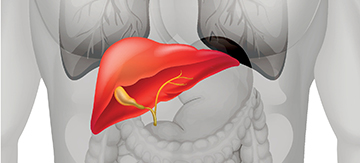Intestinal bacteria to fight deadly liver disease

A research group led by Odense University Hospital has just received 47 million kroner from the EU to combat cirrhosis of the liver, which has a lower survival rate than several types of cancer.
Approximately 15,000 Danes have cirrhosis of the liver and about 1,500 new cases occur each year. Only 38% of patients are still alive three years after the diagnosis has been made. In comparison, 87% of Danish breast cancer patients are alive five years after diagnosis, and 56% of patients with colorectal cancer. Survival rates for liver disease have not shown the same improvement in recent years as seen for many types of cancer, but the research group GALAXY, led by Odense University Hospital, is about to change that.
The research group has just received 47 million kroner from the EU, and the head of the research group, Aleksander Krag, a professor at the University of Southern Denmark and consultant at the department of gastrointestinal and liver diseases at Odense University Hospital, has high hopes for the project.
Cirrhosis also hits the well-off
“Cirrhosis is the cause of every seventh death in the western world, and yet research into the disease has been under-prioritized for many years. This is perhaps due to alcohol being a contributing factor in the majority of cases, and that cirrhosis is therefore a taboo subject. Many believe that the disease only affects the homeless, but actually it is the wealthier people that fill waiting rooms up. They don’t think of themselves as having a drinking problem. But the liver knows it, and it keeps going without protesting until it is too late” explains Aleksander Krag.
Aleksander Krag and his colleagues have noted that people vary in their sensitivity to alcohol. About 5-10% of heavy drinkers get cirrhosis of the liver. Other people will also develop the disease even at modest drinking levels, but we cannot predict who that will be. This means that many patients are diagnosed so late that they already have irreparable damage to their livers.
Liver damage needs to be detected much earlier
The goal of the 6-year research project is to find an easy and effective way to identify the people who do not know that they have the disease. This could, for example, be a blood test can detect early liver damage and predict who will more quickly develop liver cirrhosis and are thus in most need of treatment.
The answer is expected to be related to the bacteria living in the intestine. The research group’s hypothesis is that these bacteria interact with the liver to either protect it or to promote the formation of scar tissue in the liver.
The research project starts on the 1st January 2016 and runs for six years.
Facts about the project
The project is run by a consortium called GALAXY. Besides Odense University Hospital and the University of Southern Denmark, the group includes:
- Center for Basic Metabolic Research at the University of Copenhagen
- Steno Diabetes Center
- University of Oslo (Norway)
- European Molecular Biology Laboratory, Heidelberg (Germany)
- Universitätsklinikum Bonn (Germany)
- Academy of Biomedical Research Foundation (Greece)
The two Danish companies Nordic Bioscience A/S and Nordic Rebalance A/S are also participating in the project. Nordic Bioscience will develop and test biomarkers (for example for a blood test), while Nordic Rebalance will develop and clinically test a new product that could help to treat liver fibrosis and cirrhosis.
The project has received funding from the European Union’s Horizon 2020 research and innovation programme under grant agreement No 668031.
More information:
Aleksander Krag, professor at the University of Southern Denmark and consultant at the department of gastrointestinal and liver diseases, Odense University Hospital, tel. +45 29 64 77 19
Thomas Rysgaard Jensen, communications consultant at Odense University Hospital, tel. +45 40 38 41 90



